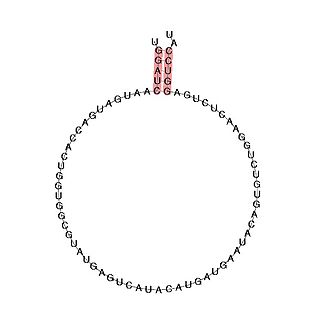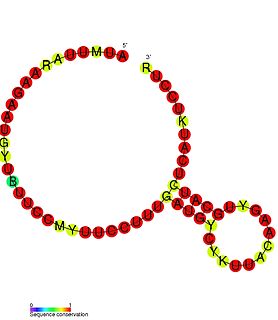Related Research Articles

Treacle protein is a protein that in humans is encoded by the TCOF1 gene.

GNAS complex locus is a gene locus in humans. Its main product is the heterotrimeric G-protein alpha subunit Gs-α, a key component of G protein-coupled receptor-regulated adenylyl cyclase signal transduction pathways. GNAS stands for Guanine Nucleotide binding protein, Alpha Stimulating activity polypeptide.

Testis-specific Y-encoded protein 1 is a protein that in humans is encoded by the TSPY1 gene.

Small nuclear ribonucleoprotein-associated protein N is a protein that in humans is encoded by the SNRPN gene.

PRP31 pre-mRNA processing factor 31 homolog , also known as PRPF31, is a protein which in humans is encoded by the PRPF31 gene.

Mesoderm-specific transcript homolog protein is a protein that in humans is encoded by the MEST gene.

Probable histone-lysine N-methyltransferase NSD2 is an enzyme that in humans is encoded by the WHSC1 gene.

Deleted in azoospermia protein 2 is a protein that in humans is encoded by the DAZ2 gene.

Pleckstrin homology-like domain family A member 2 is a protein that in humans is encoded by the PHLDA2 gene.
KCNQ1 overlapping transcript 1, also known as KCNQ1OT1, is a long non-coding RNA gene found in the KCNQ1 locus. This locus consists of 8–10 protein-coding genes, specifically expressed from the maternal allele, and the paternally expressed non-coding RNA gene KCNQ1OT1. KCNQ1OT1 and KCNQ1 are imprinted genes and are part of an imprinting control region (ICR). Mitsuya identified that KCNQ1OT1 is an antisense transcript of KCNQ1. KCNQ1OT1 is a paternally expressed allele and KCNQ1 is a maternally expressed allele. KCNQ1OT1 is a nuclear, 91 kb transcript, found in close proximity to the nucleolus in certain cell types.

Dystrophia myotonica WD repeat-containing protein is a protein that in humans is encoded by the DMWD gene.

Kelch-like protein 1 is a protein that in humans is encoded by the KLHL1 gene.

Small nucleolar RNA SNORD113 is a small nucleolar RNA molecule which is located in the imprinted human 14q32 locus and may play a role in the evolution and/or mechanism of the epigenetic imprinting process.

KCNQ1 downstream neighbour (KCNQ1DN) is a long non-coding RNA gene. In humans, it is located on chromosome 11p15.5 between the CDKN1C and KCNQ1 genes. It is an imprinted gene, expressed from the maternal allele. Reduced expression of KCNQ1DN is observed in Wilms' tumours.
In molecular biology, FMR1 antisense RNA 1 (FMR1-AS1), also known as ASFMR1 or FMR4, is a long non-coding RNA. The FMR1-AS1 gene overlaps, and is antisense to, the CGG repeat region of the FMR1 gene. Its expression is upregulated in fragile X syndrome premutation carriers, and silenced in patients with fragile X syndrome. FMR1-AS1 has an anti-apoptotic function.
In molecular biology, HTT antisense RNA 1, also known as HTT-AS1, is a long non-coding RNA. It is an antisense RNA which regulates the expression of the huntingtin gene.
In molecular biology, MEST intronic transcript 1, antisense RNA, also known as MESTIT1 or PEG1-AS is a long non-coding RNA. It is an imprinted gene, which is paternally expressed. In humans, it is found on chromosome 7q32, imprinted genes on chromosome 7 are believed to be involved in Russell-Silver syndrome (RSS). However, it is believed that MESTIT1 is unlikely to cause Russell-Silver syndrome as there is a lack of mutations in this gene in Russell-Silver syndrome patients. MESTIT1 may regulate the expression of the MEST gene.
In molecular biology, WT1 antisense RNA, also known as WT1-AS or WIT1, is a long non-coding RNA. In humans, it is found on chromosome 11 and is expressed in kidney. It is transcribed in the opposite direction to the WT1 gene. It is functionally imprinted in the human kidney, where only the paternal allele is expressed, but not in the foetal kidney.

UBE3A-ATS/Ube3a-ATS (human/mouse), otherwise known as ubiquitin ligase E3A-ATS, is the name for the antisense DNA strand that is transcribed as part of a larger transcript called LNCAT at the Ube3a locus. The Ube3a locus is imprinted and in the central nervous system expressed only from the maternal allele. Silencing of Ube3a on the paternal allele is thought to occur through the Ube3a-ATS part of LNCAT, since non-coding antisense transcripts are often found at imprinted loci. The deletion and/or mutation of Ube3a on the maternal chromosome causes Angelman Syndrome (AS) and Ube3a-ATS may prove to be an important aspect in finding a therapy for this disease. While in patients with AS the maternal Ube3a allele is inactive, the paternal allele is intact but epigenetically silenced. If unsilenced, the paternal allele could be a source of active Ube3a protein in AS patients. Therefore, understanding the mechanisms of how Ube3a-ATS might be involved in silencing the paternal Ube3a may lead to new therapies for AS. This possibility has been demonstrated by a recent study where the drug topotecan, administered to mice suffering from AS, activated expression of the paternal Ube3a gene by lowering the transcription of Ube3a-ATS.

Makorin ring finger protein 3 is a protein that in humans is encoded by the MKRN3 gene.
References
- ↑ "Human PubMed Reference:". National Center for Biotechnology Information, U.S. National Library of Medicine.
- ↑ Hayward BE, Bonthron DT (2000). "An imprinted antisense transcript at the human GNAS1 locus". Hum Mol Genet. 9 (5): 835–841. doi: 10.1093/hmg/9.5.835 . PMID 10749992.